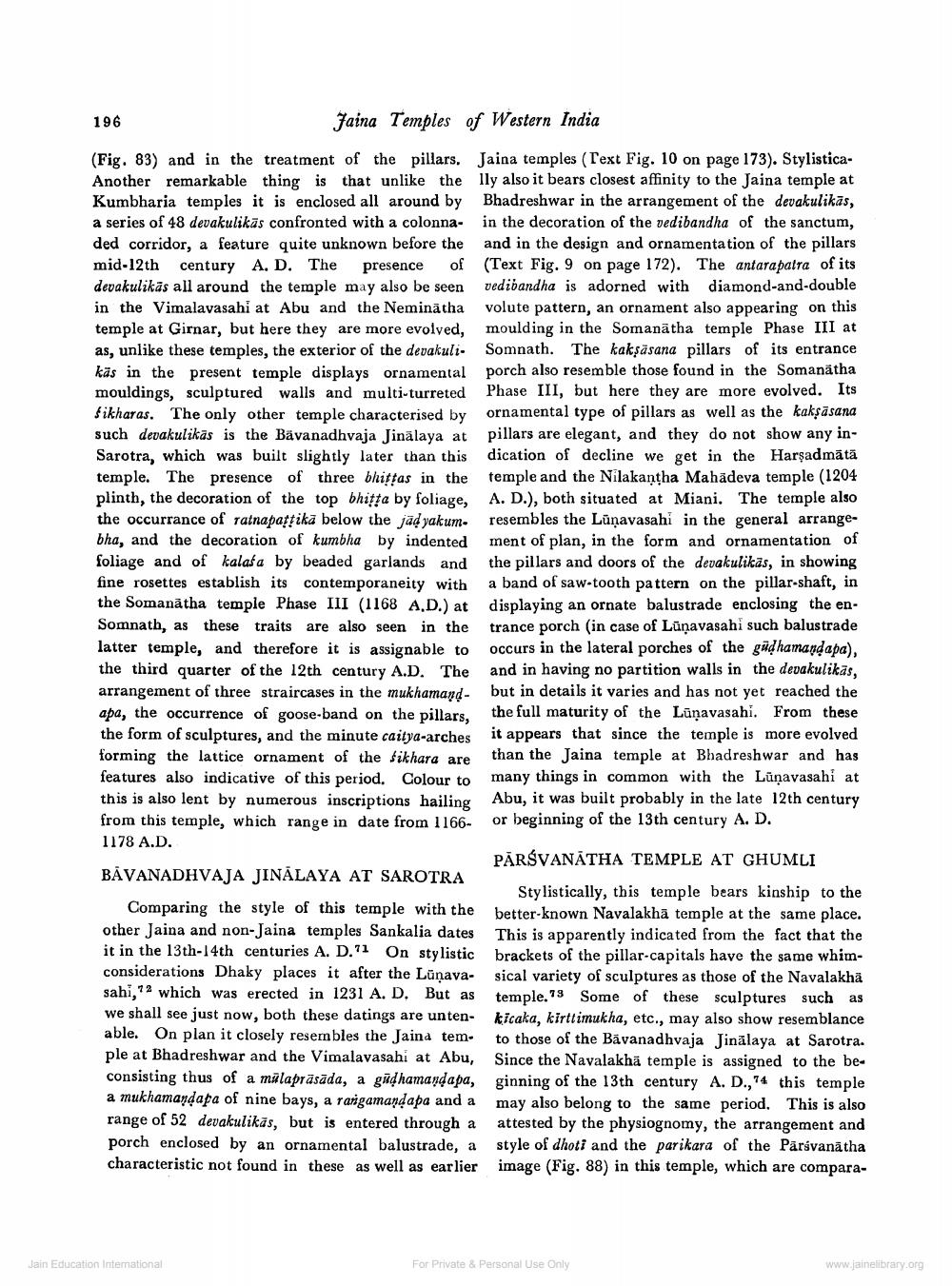________________
196
Faina Temples of Western India
(Fig. 83) and in the treatment of the pillars. Jaina temples (Text Fig. 10 on page 173). StylisticaAnother remarkable thing is that unlike the lly also it bears closest affinity to the Jaina temple at Kumbharia temples it is enclosed all around by Bhadreshwar in the arrangement of the devakulikās, a series of 48 devakulikās confronted with a colonna in the decoration of the vedibandha of the sanctum, ded corridor, a feature quite unknown before the and in the design and ornamentation of the pillars mid-12th century A. D. The presence of (Text Fig. 9 on page 172). The antarapatra of its devakulikās all around the temple may also be seen vedibandha is adorned with diamond-and-double in the Vimalayasahi at Abu and the Neminātha volute pattern, an ornament also appearing on this temple at Girnar, but here they are more evolved, moulding in the Somanätha temple Phase III at as, unlike these temples, the exterior of the devakuli. Somnath. The kaksāsana pillars of its entrance kās in the present temple displays ornamental porch also resemble those found in the Somanatha mouldings, sculptured walls and multi-turreted Phase III, but here they are more evolved. Its Sikharas. The only other temple characterised by ornamental type of pillars as well as the kakşāsana such devakulikas is the Bävanadhvaja Jinälaya at pillars are elegant, and they do not show any inSarotra, which was built slightly later than this dication of decline we get in the Harsadmātā temple. The presence of three bhittas in the temple and the Nilakantha Mahadeva temple (1204 plinth, the decoration of the top bhitta by foliage, A. D.), both situated at Miani. The temple also the occurrance of ratnapattikā below the jād yakum. resembles the Lūņavasahi in the general arrangebha, and the decoration of kumbha by indented ment of plan, in the form and ornamentation of foliage and of kalaša by beaded garlands and the pillars and doors of the devakulikās, in showing fine rosettes establish its contemporaneity with a band of saw-tooth pattern on the pillar-shaft, in the Somanatha temple Phase III (1168 A.D.) at displaying an ornate balustrade enclosing the enSomnath, as these traits are also seen in the trance porch (in case of Lūņavasahi such balustrade latter temple, and therefore it is assignable to occurs in the lateral porches of the gūdhamandapa), the third quarter of the 12th century A.D. The and in having no partition walls in the devakulikās, arrangement of three straircases in the mukhamand- but in details it varies and has not yet reached the apa, the occurrence of goose-band on the pillars, the full maturity of the Lūņavasahi. From these the form of sculptures, and the minute caitya-arches it appears that since the temple is more evolved forming the lattice ornament of the Sikhara are than the Jaina temple at Bhadreshwar and has features also indicative of this period. Colour to many things in common with the Lūņavasahi at this is also lent by numerous inscriptions hailing Abu, it was built probably in the late 12th century from this temple, which range in date from 1166. or beginning of the 13th century A. D. 1178 A.D.
PĀRSVANĀTHA TEMPLE AT GHUMLI BĀVANADHVAJA JINĀLAYA AT SAROTRA
Stylistically, this temple bears kinship to the Comparing the style of this temple with the better known Navalakhā temple at the same place. other Jaina and non-Jaina temples Sankalia dates This is apparently indicated from the fact that the it in the 13th-14th centuries A. D.1 On stylistic brackets of the pillar-capitals have the same whimconsiderations Dhaky places it after the Lunava- sical variety of sculptures as those of the Navalakhä sahi,72 which was erected in 1231 A. D. But as temple.79 Some of these sculptures such as we shall see just now, both these datings are unten- kicaka, kirttimukha, etc., may also show resemblance able. On plan it closely resembles the Jaina tem- to those of the Bävanadhvaja Jinālaya at Sarotra. ple at Bhadreshwar and the Vimalavasahi at Abu, Since the Navalakha temple is assigned to the beconsisting thus of a malaprāsāda, a gūdhamaydapa, ginning of the 13th century A. D.,74 this temple a mukhamandapa of nine bays, a rarigamandapa and a may also belong to the same period. This is also range of 52 devakulikās, but is entered through a attested by the physiognomy, the arrangement and porch enclosed by an ornamental balustrade, a style of dhoti and the parikara of the Pārsvanātha characteristic not found in these as well as earlier image (Fig. 88) in this temple, which are compara
Jain Education International
For Private & Personal use only
www.jainelibrary.org




